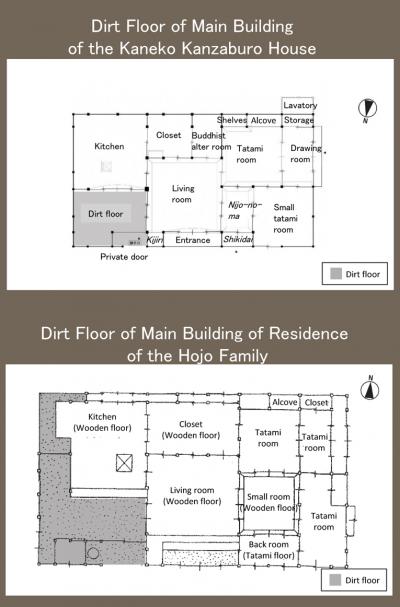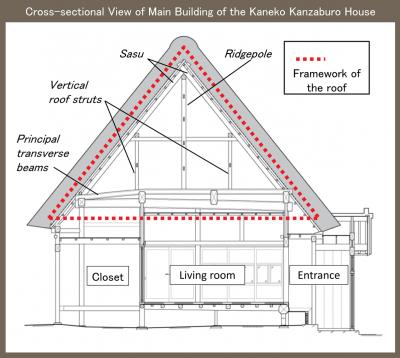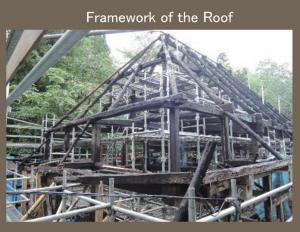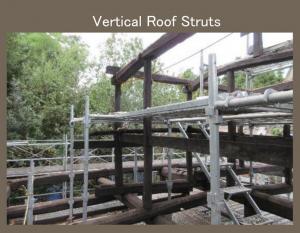本文
【金子勘三郎家】 パネル7(Part 7)
↵
其の七 土間と小屋組の特徴
狭い土間の意味は?
金子勘三郎家主屋では、土間を「ニワ」、その奥を「オマエ」と呼んでいます。
一般的に「ニワ」は、農作業を中心とした作業場として使われます。しかし、当家主屋の場合は北側壁面にカマドがあるため、炊事場であったと考えられます。
また、北條家住宅(※1)をはじめとする佐渡の他の民家と比べても、「ニワ」が狭いことがわかります。
これは、江戸時代の笹川集落では砂金採取が生業の中心であり、広い作業空間は不要であったためと推測されます。
そして、砂金山閉山後も敷地内に納屋や牛納屋などを新築することで、「ニワ」を拡張する必要がなく、今日まで受け継がれてきたものと考えられます。
茅葺の小屋組
当家主屋の小屋組は叉首組(※2)となっており、上屋梁(※3)の上に棟束(※4)や小屋束(※5)を立てて、叉首を支える構造になっています。
これは、佐渡の茅葺民家に共通する特徴で、当家主屋では、「オマエ」の天井部分から小屋組の状況をみることができます。
- ※1 北條家住宅
- 佐渡市泉地区に所在し、18世紀後半の建築と推定される民家(国指定重要文化財)
- ※2 叉首組
- 2本の丸太を棟部分で交差させ、中央に束と呼ばれる柱を立てて組み合わせる小屋組
- ※3 上屋梁
- 柱や束の上に横に渡して、建物の上からの荷重を支える部材
- ※4 棟束
- 屋根の棟部分を支える柱
- ※5 小屋束
- 屋根(叉首)を支える柱
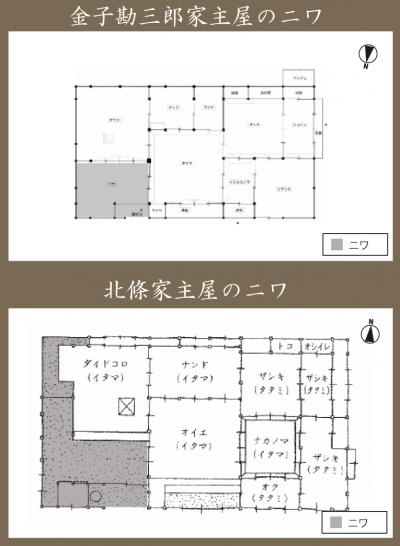
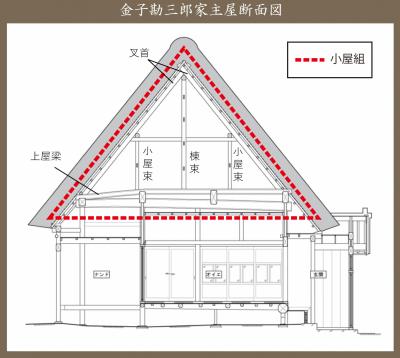
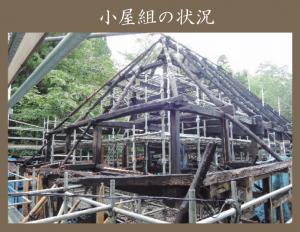
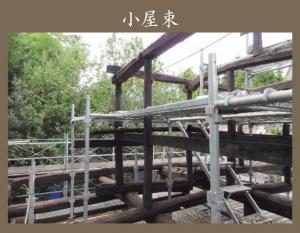
Part 7 Features of the Dirt Floor and Roof Framework
Why is the Dirt Floor Area so Small?
In the main building, the dirt floor area is called the niwa, and the main living space behind the niwa is called omae.
Generally, the niwa is a workspace, mainly for doing farm work. However, in this building, the family had some ovens along the northern wall, so this niwa is thought to have been used as a kitchen.
Compared to the other private houses in Sado, including the residence of Hojo family*1, the niwa of this building is quite small.
This is presumably because the residents did not need a spacious workspace as placer gold mining was the main source of income in this settlement during the Edo period.
It is thought that the Kaneko family did not need to expand the niwa after the closure of the placer gold mine as they built a new shed and a cow barn in the premises. Those buildings have been passed down to the present day.
Thatched Roof Framework
The framework of the roof of this main building is in the sasu-style*2. Above the principal transverse beams*3, is the ridgepole*4, which runs along the top of the frame, with vertical roof struts*5 between beams to provide support for the triangular frame.
This feature is common in thatched-roof houses on Sado Island. In this main building, the framework of the roof can be seen from the ceiling of the omae (kitchen).
- *1 The residence of the Hojo family:
- a private house located in Izumi district in Sado City, presumed to have been built in the late 18th century. It is a National Important Cultural Property.
- *2 Sasu-style roof:
- a roof hut assembly formed by crossing two logs at the ridge and joining them with a pillar erected in the center.
- *3 Principal transverse beams:
- also called a tie beam, these beams run perpendicular to the ridgepole and holds up the diagonal braces that make the triangular shape of the roof.
- *4 Ridgepole:
- the topmost horizontal beam in a roof.
- *5 Vertical roof struts:
- pillars that support the ridgepole and the roof.
